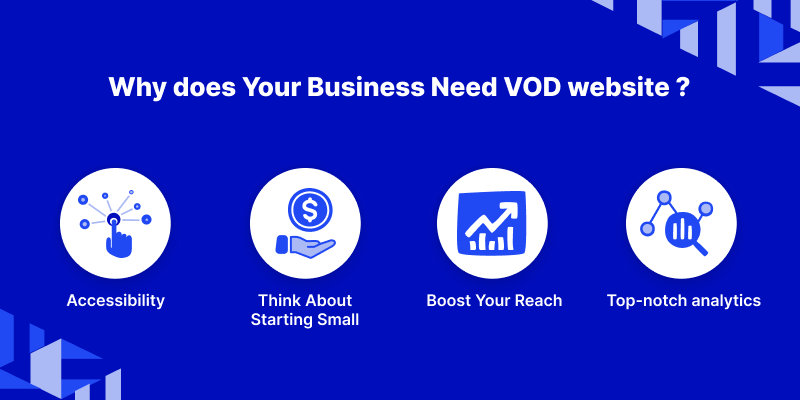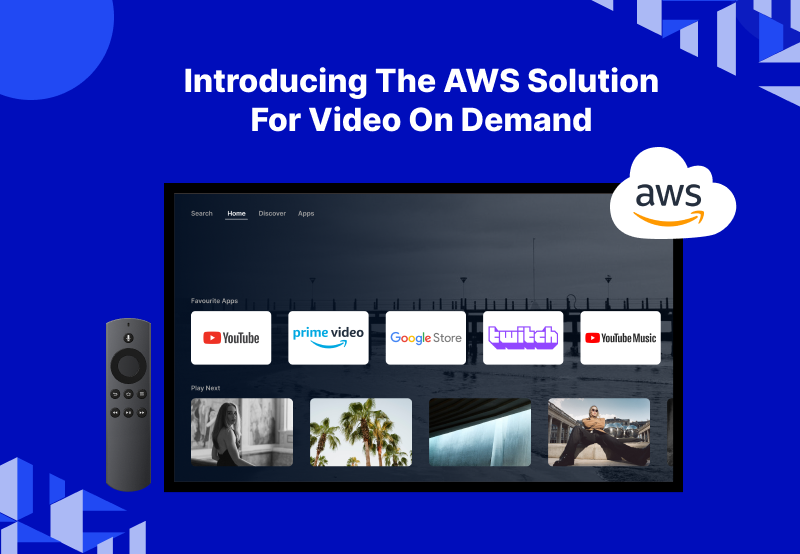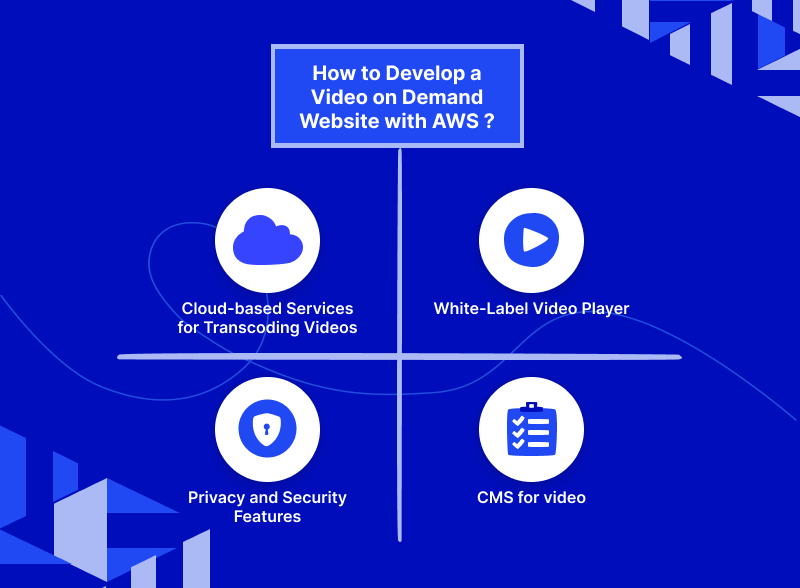You’re interested in VOD streaming, right? You’ll acquire knowledge of How to create a Video On Demand(VOD) website using AWS services?
Let’s quickly jump into the article to check all this out.

The term VOD refers to video on demand. To watch previously recorded recordings that have been posted to the video library, users can access this online video streaming platform from any location, at any time, and on any device.
Here, “video service” refers to any platform that allows users to access videos, TV shows, and movies whenever they want. Viewers that use VOD have a wide range of options for what and when to watch.
Netflix, Disney+, Amazon prime, and many more internet streaming services are well-known examples of video-on-demand enterprises.
Why does Your Business Need Video On Demand(VOD) website?
Market growth for VOD services is phenomenal. At an all-time high, there is a growing demand for VOD services. By building their own VOD platforms, several companies are utilizing this expansion.
Here are some explanations for why your company needs a VOD platform.

- Accessibility: Obtaining video content doesn’t need going to a physical location. Users only need to click from their media devices to access VOD content.
- Think About Starting Small: Companies can easily set up and start a VOD platform for less money. Streaming services for video on demand are more affordable than other methods of media delivery.
- Boost Your Reach: By using VOD internet streaming, you can persuade people to become your devoted patrons. High-end analytics can be used to deliver a customized movie based on the customer’s preferences. With a VOD platform, you may significantly raise your conversion rate.
- Top-notch analytics: Viewers use their devices to access VOD services. This enables companies to get information about consumer behavior and preferences.
The providers of VOD services also offer a separate dashboard for analytics. The client information can be used to create more effective marketing plans for VOD content.
How Does Video On Demand Work?
When you use VOD, data packets are sent from servers like AWS that host video content to your video player.
There are three main ways that VOD providers often promote their video-on-demand content:
- SVOD (Subscription Video On Demand)
- TVOD (Transactional Video On Demand)
- AVOD (Ad-Supported Video On Demand)

SVOD (Subscription Video On Demand)
Subscription Video on Demand is known by the term SVOD. When monthly or yearly subscription costs are paid, customers of SVOD have unlimited access to the full platform’s video catalog on any device with internet connectivity.
Depending on the video platform, subscription costs range from monthly to yearly.
As consumers pay recurrent fees to access the video, SVOD assists in providing a steady source of cash each month or every year.
Netflix, Disney+, and Hulu are a few of the most well-known video platforms that rely on the SVOD model for revenue.
TVOD (Transactional Video On Demand)
Users pay money for a specific video to access a movie or series using this approach. There are two sorts of TVOD; the first is the EST approach, in which customers pay money to download or permanently purchase video content.
The DRT approach is the alternative; consumers pay money to access the video for a set amount of time or a set number of viewings.
It is comparable to renting a movie for less money than using the EST approach.
AVOD (Ad-Supported Video On Demand)
Run video ads to promote your video streaming platform! Run various forms of advertising on your videos across websites, mobile applications, and TV apps, as well as any other form of video ad units that the video advertising platform supports, and monetize using the ad-supported model (AVOD).
Additionally, you may create and manage your platform using both paid and advertising models from a single admin-cms.
Is VOD streaming the same as live streaming?
The two types of streaming—live and VOD—are not the same. The main distinction between live content and VOD content is that live content is transmitted in real-time, whereas VOD video is recorded and typically edited before you view it.
Ultimately, a lot of brands produce both live streaming and VOD content.
Consider your content strategy over the long term as you develop your team’s video marketing approach.
Your live streams can be recorded, and then you can watch them afterward as videos. You can expand your VOD content library by watching live feeds.

VOD is basically a way to watch pre-recorded video content. You can and should record live streaming content for later access on a VOD solution if you want to maximize your video monetization prospects.
You may expand your audience and fully monetize your material by recording it for later use with VOD distribution. It shouldn’t be a choice between streaming and video on demand; both should be used.
Even if you have the option to use both live streaming and VOD material for your business, make sure the streaming platform you choose has the capacity to handle both distribution strategies.
With a single platform, you can manage many distribution channels more easily and save time, money, and frustration in the long run.
Introducing the AWS Solution for Video On Demand
After you’ve produced a magnificent piece of content, what could be better than engaging with your viewer?
We’re talking about live broadcasts here, where you interact with your audience as you deliver that content.
Technical obstacles must be overcome in order to satisfy viewer needs and standardize viewing formats.
In order to accommodate viewers with various internet connections, cloud video transcoding produces many “renditions” at various bitrates.

To cater to such a massive audience, we develop the website in the AWS Cloud with the aid of AWS Media Services.
Furthermore, to transport, prepare, process, and serve video and on-demand content in the cloud, we select AWS Media services.
With this new simplified method, all you have to do is submit your videos, define the job settings, and the videos are encoded; you then get a notification of the work’s progress.
How to Develop a Video on Demand Website with AWS Services
On the market, there are a lot of VOD platforms. Their toolkits range in price and variety.
Here are some key qualities to consider when picking an online video platform(Like Bagisto, Magento, etc) to create a VOD website.

White-Label Video Player
The practice of one business creating a product, repackaging it, and allowing another business to sell it under its own identity is referred to as “white labeling.”
Furthermore, a white-label service is one of the most crucial components for developing a website for streaming video.
AWS has the White label branding capabilities, which will ensure that your brand is prominent.
Cloud-based Services for Transcoding Videos
The majority of contemporary video cameras can record in a variety of sizes and formats. Due to differing internet connections and device capabilities, folks who watch your videos must likewise watch in various video sizes.
There are some technical difficulties in accommodating viewer needs and standardizing viewing formats.
This issue is resolved via cloud video transcoding, which generates numerous “renditions” at various bitrates for viewers with various internet speeds.
Privacy and Security Features
You cannot compromise website security or user privacy in this day and age of cyberattacks and the prevalence of the dark web.
You must protect users’ privacy because you’ll likely want them to register with you and give you their personal information, including a credit card.
Phishing scams target these websites, mainly if they host advertisements. As it guards your VOD platform against hacking and content theft, advanced security keeps you and your users secure.
CMS for video
To host and control material, a broadcaster needs a central interface.
Even with content that has been processed and is prepared to serve audiences, you still need a system to index assets, maintain related metadata and aid in limiting who may access playback. A content management system, sometimes known as a CMS, plays this duty.
AWS services leveraged by VOD
To provide a highly available and robust architecture, this solution makes use of the following AWS services:

AWS Elemental MediaConvert
An online video converting solution with broadcast-quality functionality is AWS Elemental MediaConvert.
This is used to convert media files from their original formats so that they may be played back on computers, tablets, smartphones, and other hardware.
AWS Elemental MediaPackage
Your video is securely processed and safeguarded by AWS Elemental MediaPackage before being delivered online.
AWS Elemental MediaPackage generates video streams from a single video input that can be played on connected TVs, smartphones, laptops, tablets, and gaming consoles.
Amazon Simple Queue Service
The workflow output will be captured using Amazon Simple Queue Service (SQS).
You can expand and decouple serverless applications, distributed systems, as well as microservices using this fully managed message queuing service.
Amazon CloudFront
A content delivery network (CDN) solution called Amazon CloudFront is designed for ease of use for developers and great performance.
As a result, the distribution of your video content to end viewers is sped up.

AWS Step Functions
Using AWS services, developers may create distributed apps, automate business and IT procedures, and create data and machine learning pipelines using the low-code, visual workflow solution known as AWS Step Functions.
Amazon DynamoDB
High-performance applications may be executed at any scale using Amazon DynamoDB, a fully managed, serverless, key-value NoSQL database.
You may follow the workflow’s progress and keep track of the metadata for the source and destination files.
AWS Lambda
Without provisioning or managing servers, you can run code for practically any kind of application or backend service with AWS Lambda, a serverless, event-driven compute service. It enables code execution without the need to provision or manage servers.
Amazon S3
An object storage service called Amazon Simple Storage Service (Amazon S3) provides performance, security, and data availability that are unmatched in the market.
For practically any use case, such as data lakes, cloud-native applications, and mobile apps, customers of all sizes and sectors can store and protect any quantity of data.
Amazon CloudWatch
Encoding jobs are monitored via Amazon CloudWatch.
Site reliability engineers (SREs), DevOps engineers, developers, IT managers, and product owners are the target audience for this monitoring and observability solution.
Amazon Simple Notification Service
Publish, encode, and error notifications are sent via Amazon Simple Notification Service (Amazon SNS).
This is a completely managed messaging service that may be used for both application-to-application (A2A) and application-to-person (A2P) communication.
Why would anyone choose AWS for the video-on-demand website?
HOWEVER, Amazon S3 and Amazon CloudFront offer a more systematic strategy for AWS to stream your videos.
To transcode your films into various output formats, you don’t want to start up a server; fortunately, in this post-cloud era, AWS offers a serverless solution.

However, to host films for on-demand watching in a safe and scalable manner, use Amazon S3 in conjunction with Amazon CloudFront.
When you stream video on demand (VOD), viewers can access your video at any time because it is saved on a server.
The amount of requests that your origin server must directly answer is decreased by CloudFront caching.
The request is routed to a neighboring edge site nearer to the viewer’s location when a viewer (end-user) requests a video that you serve with CloudFront.
If the movie is not previously cached, CloudFront serves it from its cache rather than the S3 bucket.
With low latency, high throughput, as well as fast transfer rates. This caching management technology expedites the distribution of your video to viewers throughout the world.
Some of the following features are provided by video-on-demand websites using AWS solutions:

- Using Amazon CloudFront, videos are delivered to users in a format suitable for a variety of playing devices.
- Scalability of the CloudFront CDN’s video delivery solution
- Video inputs may optionally be archived automatically to help save money on storage.
- Amplify and CloudFormation is used to create and deploy the solution quickly.
- For simple access by downstream consumers, input file information, task settings, and output details are stored in a DynamoDB table.
- Optional triggers include metadata files and video files.
Conclusion:
However, it’s not easy to build your own video-on-demand website. For modern enterprises, video streaming is a potent tool. Meanwhile, it might be intimidating to know where to begin and how.
Determining a video-on-demand platform and creating a VOD website for your company are both crucial decisions, which is why we’ve covered all the information you need to know.
The Video On Demand (VOD) on AWS solution has made it easier to create a VOD library of your video assets.
Support
So, that was much about How to create a Video On Demand(VOD) website using AWS services? for any queries or doubts reach out to us at [email protected], you can also raise a ticket at our HelpDesk System.


Be the first to comment.